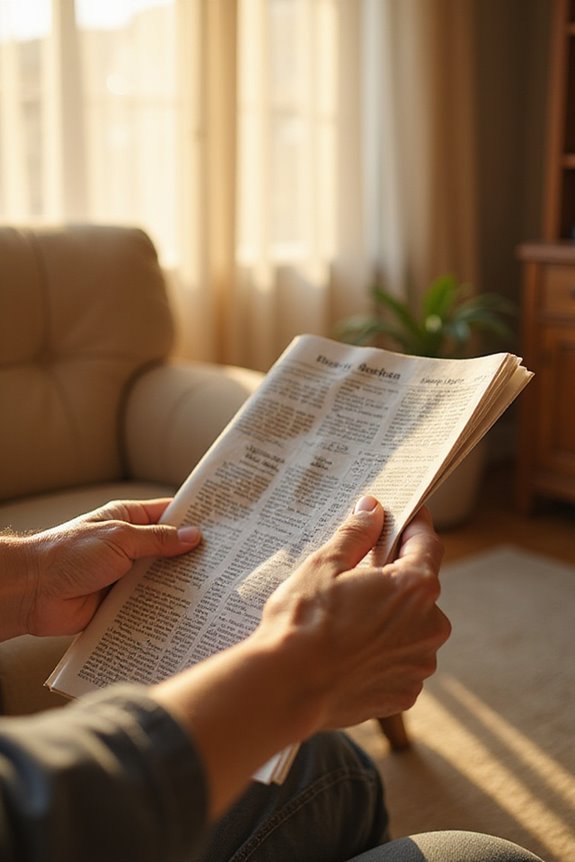Maintaining hearing and vision aids requires consistent care. Daily cleaning routines include using soft cloths and brushes to remove debris and oils. Regular inspections of components like earmolds and tubes are crucial to avoid performance issues. Professional cleaning should occur every six months to guarantee peak function, utilizing ultrasonic methods as necessary. Moisture protection is essential; use drying kits and store devices in dry locations. Continued maintenance enhances device longevity and user experience. More insights follow.
Key Takeaways
- Establish a daily cleaning routine using soft brushes and microfiber cloths to maintain functionality and appearance of hearing and vision aids.
- Regularly inspect and replace earmolds, tubes, and wax guards to ensure optimal sound quality and performance.
- Schedule professional cleanings every six months to remove buildup and receive necessary adjustments from an audiologist.
- Store devices in protective cases and use moisture-wicking covers to prevent damage from humidity and sweat.
- Replace batteries regularly and monitor their performance to maintain consistent power for your devices.
Daily Cleaning Routines
Daily cleaning routines for hearing and vision aids are vital for maintaining peak functionality and longevity. Implementing effective cleaning techniques guarantees devices operate at their best while prolonging their lifespan.
Hearing Aids:
- Brush microphones daily with a soft-bristled brush to remove debris.
- Wipe surfaces with a soft, dry cloth to eliminate oils and dirt.
- For in-the-ear models, clean earmolds using alcohol-free cleaners.
- Store in a dry, cool location.
Vision Aids:
- Clean lenses daily with a microfiber cloth and appropriate solution.
- Wipe frames regularly to prevent dirt buildup.
- Store eyeglasses in protective cases to avoid damage.
Establishing consistent maintenance schedules for both hearing and vision aids is essential for effective performance and user satisfaction.
Replacement and Maintenance of Parts
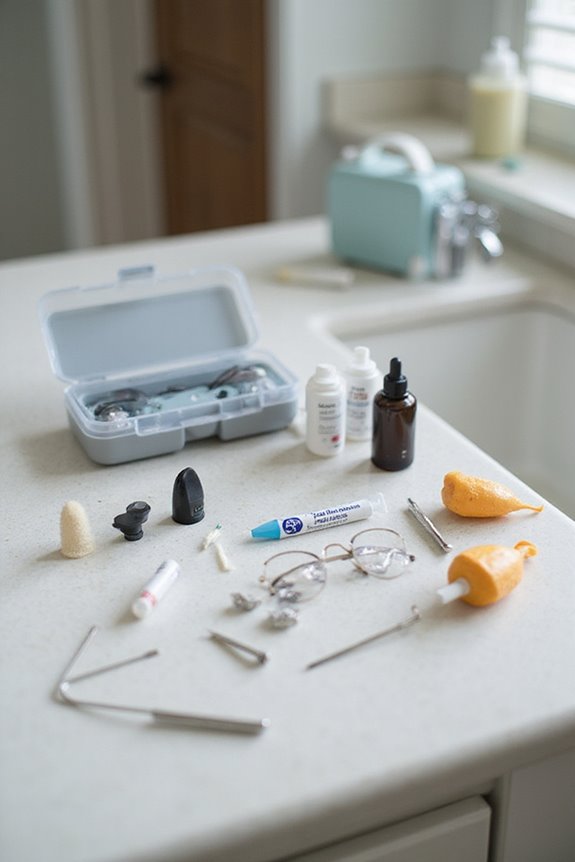
The replacement and maintenance of parts for hearing aids are crucial to ensuring ideal device functionality and user satisfaction. Regular inspection of replacement part types such as earmolds, tubes, and wax guards is essential. Damaged components can greatly impact sound quality and device performance.
Cost considerations vary based on the brand and model, with some manufacturers offering replacement parts and support services. Users should consult with audiologists to determine when replacements are necessary.
A maintenance schedule that includes prompt battery changes and moisture control is essential for longevity. Utilizing specialized tools and equipment facilitates proper part replacement, ensuring optimal function. Regular checks and professional maintenance every 3-6 months can help prevent major issues, enhancing overall device performance.
Professional Cleaning and Servicing
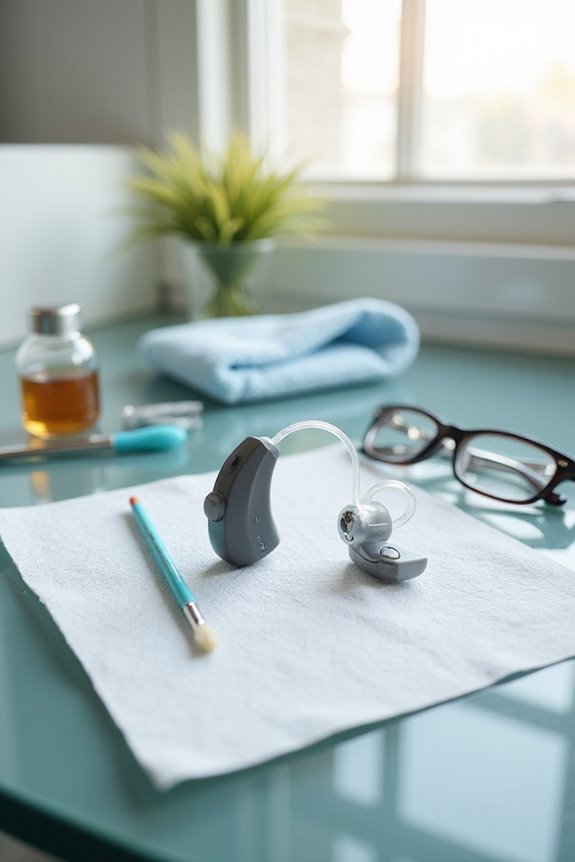
Professional cleaning and servicing play an essential role in the maintenance of hearing and vision aids, guaranteeing they function at their best. Regular cleanings, recommended every six months, prevent buildup and extend device lifespan, while also identifying potential issues early.
Hearing Aids:
- Ultrasonic cleaning removes deep wax and debris.
- Micro tools clean delicate components without damage.
Vision Aids:
- Specialized lens cleaning removes oils and dust.
- Frame adjustments guarantee proper fit and comfort.
Professional expertise enhances device performance, with audiologists and vision specialists providing adjustments based on current assessments. Additionally, regular cleaning is vital for maintaining advanced noise-canceling capabilities, which improve sound clarity in various environments. Client education is integral, equipping users with knowledge for daily care. Regular servicing fosters a community of informed users, promoting ideal health and device functionality.
Moisture and Environmental Protection
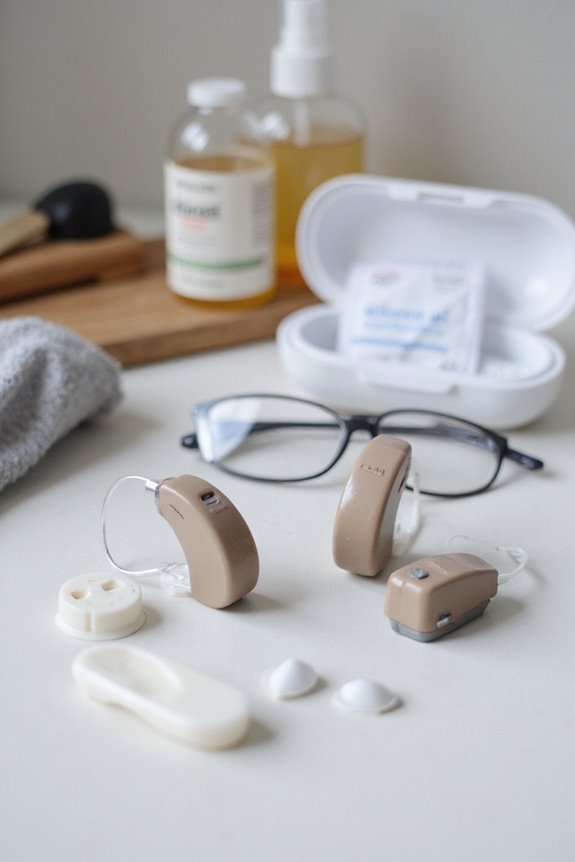
Moisture poses a significant threat to the functionality and longevity of hearing aids, making effective environmental protection vital. Hearing aids equipped with moisture-resistant features, such as protective coatings and seals, are ideal for humid environments.
Protective Accessories:
- Moisture-wicking covers and sleeves absorb sweat, enhancing comfort.
- Physical covers, like Ear Gear, shield devices from splashes.
Dehumidifiers and Drying Systems:
- Electronic dehumidifiers prolong lifespan by removing moisture overnight.
- Advanced systems, such as PerfectDry Lux, also sanitize devices.
Storage Practices:
- Store hearing aids in protective cases, away from humidity and heat.
- Leaving battery doors open aids in air circulation if devices get wet.
Avoiding high-moisture environments is essential to prevent moisture exposure and guarantee peak performance. Regular maintenance is necessary for device durability. Additionally, utilizing devices with adaptive noise cancellation can further enhance the listening experience in various environments.
Handling and Usability Considerations
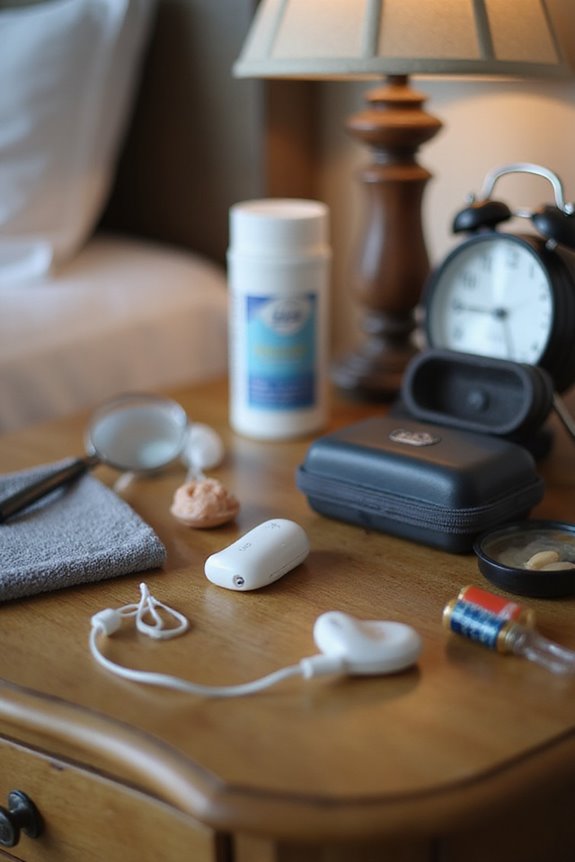
Guaranteeing ideal handling and usability of hearing and vision aids is critical for enhancing user experience and device effectiveness.
Device Compatibility
- Selecting lightweight glasses minimizes interference with hearing aids, promoting user comfort.
- Trying on glasses with hearing aids guarantees proper fit and function.
- Ergonomically designed aids enhance comfort during prolonged use.
User Comfort
- Consultation with professionals provides personalized recommendations for frame styles and models.
- Devices with adjustable components accommodate individual ear shapes, improving usability.
- Users with dexterity limitations should opt for aids with simple controls and larger buttons.
Regular maintenance, including routine cleaning and organized storage, is essential for prolonging device lifespan and guaranteeing peak functionality. Following manufacturer guidelines prevents damage and enhances safety. Additionally, considering battery life and charging features ensures that devices are always ready for use when needed.
Common Issues From Poor Maintenance
Neglecting maintenance for hearing and vision aids can lead to a range of significant issues that impair their functionality and effectiveness. For hearing aids, common problems include:
- Earwax Buildup: Regular cleaning is essential to prevent accumulation, which can distort sound quality.
- Distorted Sound: Debris obstructing the sound outlet can result in muffled hearing.
- Feedback and Whistling: Poor fitting or dirt can cause annoying feedback.
In vision aids, challenges often arise from:
- Lens Scratches: Improper handling and cleaning techniques can lead to scratches on lenses, diminishing clarity.
- Frame Damage: Neglected frames may suffer from wear, causing discomfort and misalignment.
Addressing these maintenance issues is critical to ensuring peak performance and longevity of both hearing and vision aids.
Tips for Battery Care
Proper battery care is essential to maintaining the functionality of hearing aids and vision aids. Adhering to specific practices guarantees battery longevity and peak performance.
Storage and Handling:
- Store batteries in a cool, dry place, away from moisture and heat.
- Remove activation stickers from zinc-air batteries prior to use and wait a few minutes before insertion.
- Avoid pulling tabs too early to prevent unnecessary exposure to air.
Charging Guidelines:
- For rechargeable batteries, charge overnight and maintain a partial charge of about 50% during storage.
- Always turn off devices when not in use.
Disposal:
– Proper disposal of depleted batteries is vital to prevent environmental harm. Confirm batteries are disposed of according to local regulations.
Importance of Regular Inspections
Regular inspections of hearing and vision aids are essential for maintaining ideal sensory health, as they facilitate early detection of impairments. These inspections help identify vision issues, such as cataracts and glaucoma, and enable the early detection of gradual hearing loss.
Key Benefits:
- Health Risks Mitigation: Early detection reduces complications, such as falls or social isolation.
- Timely Intervention: Inspections support the use of devices like hearing aids or cochlear implants, enhancing quality of life.
- Guidelines: Vision screenings are recommended annually for adults over 50, while hearing screenings vary by age.
Enhancing Device Longevity and Performance
Maintaining hearing and vision aids not only contributes to immediate sensory health but also greatly impacts their longevity and performance.
Daily Care
- Clean devices daily with a soft, dry cloth.
- Avoid water and household cleaners; these can harm sensitive components.
Moisture Protection
- Store devices in a dry, ventilated area or use drying kits.
- Avoid exposure to water and humidity to reduce internal damage.
Battery Maintenance
- Regularly replace disposable batteries every 3 to 10 days.
- Use high-quality batteries to guarantee consistent power.
Professional Servicing
- Schedule routine check-ups for performance optimization.
- Consult professionals for necessary device upgrades to enhance functionality. Additionally, consider the battery life of your devices as it plays a crucial role in their overall performance.
Frequently Asked Questions
Can I Use Regular Household Cleaners on My Aids?
Using regular household cleaners on aids is like mixing oil and water; they don’t belong together. Safe alternatives, such as specialized cleaning products, guarantee longevity and ideal performance, fostering a sense of belonging in caring for personal devices.
Are There Specific Storage Recommendations for Hearing and Vision Aids?
Specific storage recommendations emphasize ideal storage conditions and effective device organization. Proper cases, stable surfaces, and moisture avoidance enhance longevity, while consistent routines prevent loss, ensuring these essential aids remain accessible and protected for daily use.
How Do I Know When It’s Time to Replace My Devices?
Like a withering flower, performance indicators signal when devices fade. When sound clarity diminishes or repairs become burdensome, it’s time to contemplate a new bloom, as device lifespan typically ranges from three to seven years.
What Should I Do if My Device Gets Wet Accidentally?
When a device encounters water damage, immediate actions include removing it from the water, turning it off, and initiating device drying. Careful drying and assessment are essential for restoring functionality and preventing further issues.
Can I Clean My Aids With Water or Soap?
The question of cleaning aids with water or soap highlights the importance of proper cleaning techniques. Maintenance tips emphasize using mild soap only for detachable components while avoiding moisture on the entire device to guarantee longevity.





